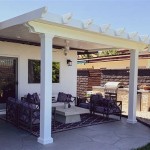How To Build A Screen Porch On A Patio
Transforming an existing patio into a screened porch is a valuable home improvement project. It extends the usability of outdoor spaces, providing protection from insects, the elements, and harsh sunlight. This article details the process of building a screen porch on an existing patio, outlining the necessary steps from planning and permitting to construction and finishing.
The decision to enclose a patio with screens is often motivated by the desire to create a more comfortable and functional outdoor living area. A screen porch provides a space for relaxation, dining, and entertaining without the nuisance of mosquitos, flies, and other pests. Furthermore, it offers a degree of protection from rain and wind, allowing for enjoyment of the outdoors even during inclement weather. Before commencing the project, careful planning and adherence to local building codes are essential.
Planning and Permitting
The initial stage of any construction project is planning. This involves assessing the existing patio, developing a design, and obtaining the necessary permits. A thorough evaluation of the patio's structural integrity is critical. The existing slab must be in good condition and capable of supporting the weight of the screen porch structure. If the patio has cracks, settling, or other damage, repairs will be necessary before proceeding.
Design considerations include the size and configuration of the screen porch, the type of screening material, the framing materials, and the roof structure. The design should complement the existing house and provide adequate protection from the elements. Consider the prevailing wind direction and sun exposure when determining the orientation and placement of the screen porch. The height of the porch should allow for adequate headroom and ventilation.
Local building codes and zoning regulations dictate the requirements for construction projects. Before starting any work, contact the local building department to obtain the necessary permits. The permitting process typically involves submitting architectural drawings and a site plan for review. Be prepared to provide detailed information about the proposed structure, including its dimensions, materials, and methods of construction. Failure to obtain the required permits can result in fines, delays, and even the forced removal of the structure.
A detailed materials list is essential for accurate cost estimation and efficient project management. This list should include all lumber, screening materials, fasteners, roofing materials, and any other components required for the construction. It is advisable to purchase high-quality materials to ensure the longevity and durability of the screen porch.
Consider hiring a professional contractor if you lack the necessary skills or experience to complete the project safely and effectively. A qualified contractor can provide valuable guidance and ensure that the screen porch is built to code and meets your design specifications. Obtain multiple bids from different contractors to compare prices and services. Check references and review their past work before making a decision.
Framing and Roofing
The framing process begins with setting posts to support the roof structure and screens. Pressure-treated lumber is recommended for all framing components that are in contact with the ground or exposed to the weather. The posts should be securely anchored to the patio slab using concrete anchors or other appropriate fasteners. Ensure that the posts are plumb and properly spaced according to the design plans.
Once the posts are in place, construct the top plate and the bottom plate to create the framework for the screens. The top plate is attached to the top of the posts, while the bottom plate is attached to the patio slab or the base of the posts. Ensure that the plates are level and securely fastened to the posts. These plates will provide structural support for the screens and the roof.
The roof structure can be a simple shed roof or a more complex gable roof, depending on the design and aesthetic preferences. A shed roof is easier to construct and requires less material, while a gable roof provides more headroom and visual appeal. Regardless of the roof design, it is crucial to ensure that the roof is properly sloped to allow for water runoff. Use roofing materials that are compatible with the existing house and provide adequate protection from the elements.
Rafters are installed to support the roof decking. The rafters should be spaced according to the roofing material manufacturer's specifications. Ensure that the rafters are properly aligned and securely fastened to the top plate and ridge board. Install roof decking, typically made of plywood or oriented strand board (OSB), over the rafters. The decking provides a solid surface for the roofing materials.
Apply a waterproof membrane or underlayment to the roof decking to prevent water from penetrating the structure. Install the roofing materials according to the manufacturer's instructions. Common roofing materials include asphalt shingles, metal roofing, and tile roofing. Ensure that the roofing is properly sealed and flashed to prevent leaks. Gutters and downspouts should be installed to direct water away from the screen porch and the house foundation.
Screening and Finishing
After framing and roofing, the next step is to install the screening. There are various types of screening materials available, including fiberglass, aluminum, and vinyl-coated polyester. Fiberglass is the most common and affordable option, while aluminum is more durable and resistant to damage. Vinyl-coated polyester is the strongest and most expensive option, offering excellent protection from pets and other potential hazards.
The screening is typically attached to the framing using staples, tacks, or spline systems. A spline system involves inserting the screening into a groove in the framing using a rubber spline. This method provides a clean and professional look and allows for easy screen replacement. Ensure that the screening is taut and free of wrinkles or sags. Trim any excess screening material to create a clean edge.
Install a screen door to provide access to the screen porch. The door should be hinged and equipped with a latch or lock. Ensure that the door swings freely and closes securely. Consider adding a self-closing mechanism to prevent insects from entering the screen porch. Weatherstripping can be installed around the door frame to create a tight seal and prevent drafts.
Once the structure is built, the finishing touches contribute to the overall appearance and functionality of the screen porch. This typically includes painting or staining the wood framing, installing trim, and adding lighting and electrical outlets. Apply a primer coat to the wood framing before painting or staining. This will help the paint or stain adhere better and provide a more durable finish. Choose a paint or stain that is designed for exterior use and is resistant to fading and mildew.
Install trim around the screens, doors, and windows to conceal any gaps and create a finished look. Consider adding electrical outlets and lighting fixtures to enhance the functionality of the screen porch. Electrical work should be performed by a qualified electrician to ensure safety and compliance with local codes. Consider adding a ceiling fan to improve ventilation and create a more comfortable environment.
Furnish the screen porch with comfortable seating, tables, and other accessories to create a relaxing and inviting outdoor living space. Outdoor furniture should be durable and weather-resistant. Consider adding plants and decorative items to personalize the space. Regular maintenance, such as cleaning the screens and sweeping the floor, will help keep the screen porch in good condition and extend its lifespan.

Do It Yourself Diy Screened In Porch The Original Screen Tight System

How To Build A Screened In Porch On Concrete Extreme

Create A Three Season Room With Diy Screened In Porch

45 Awesome Diy Screened In Porch Ideas Designs On A Budget 2024 Screen House Design

Create A Three Season Room With Diy Screened In Porch

How To Convert A Flagstone Patio Into Screened In Porch

Diy Screened In Porch Makeover Blessed Beyond Crazy

Building Our Screened In Back Porch

Diy Screened Porch Newlywoodwards

Do It Yourself Diy Screened In Porch The Original Screen Tight System
See Also








